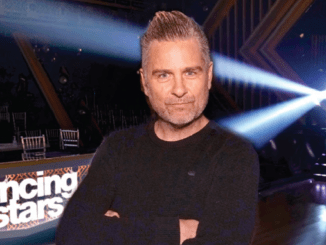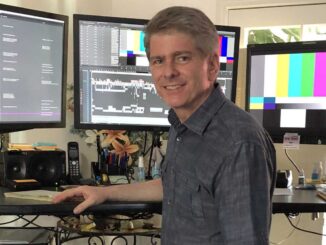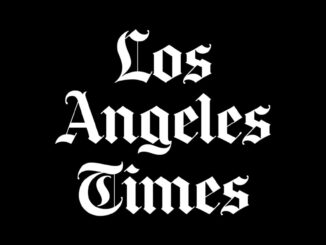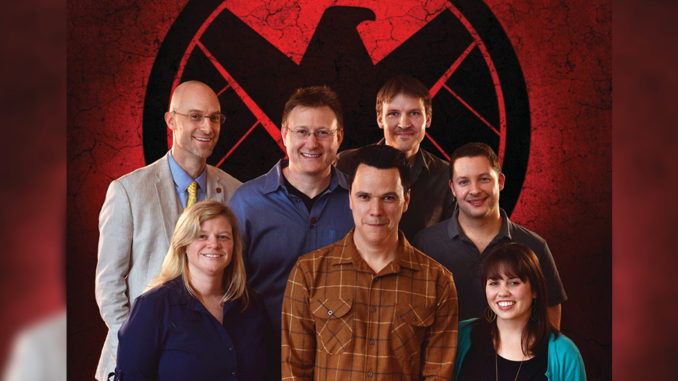
by Michael Goldman • portraits by Martin Cohen
As Marvel’s Agents of S.H.I.E.L.D. races to its second season finale May 12, the ambition of the series’ approach to the current generation of ensemble, superhero-based, action dramas was becoming increasingly clear. The ABC show’s layers include an ever-growing cast of characters who periodically change allegiance, winding plot lines that are often linked directly or indirectly to the rest of the Marvel media universe, curveballs that often hit the show straight out of the Marvel movies, a need to show respect to a sometimes fanatical fan base of comic book aficionados, some particularly sophisticated visual effects elements by network television standards, deep writing that includes elements from multiple genres, and a whole lot more. Consequently, making Agents of S.H.I.E.L.D. work just right is no easy feat. At the center of making this gargantuan effort succeed each week is the program’s picture editorial department and editing methodology.
“I do think this is one of the more challenging shows to edit on television, but that’s what makes it rewarding,” says Joshua Charson, one of three current editors on the show, and the one who has been with the program the longest, having co-edited the pilot with Paul Trejo, ACE (no longer on the show), back in 2013. “We are part of the greater Marvel universe, so those tie-ins are happening. That means we get a lot of story lines happening beyond our show, and we don’t always know the details until fairly late in the process. But to me, the big challenge is all the different genres existing in one show. In the tradition of executive producer Joss Whedon, we have elements of action, suspense, drama and comedy in almost every episode.”
TEAMWORK PREVAILS
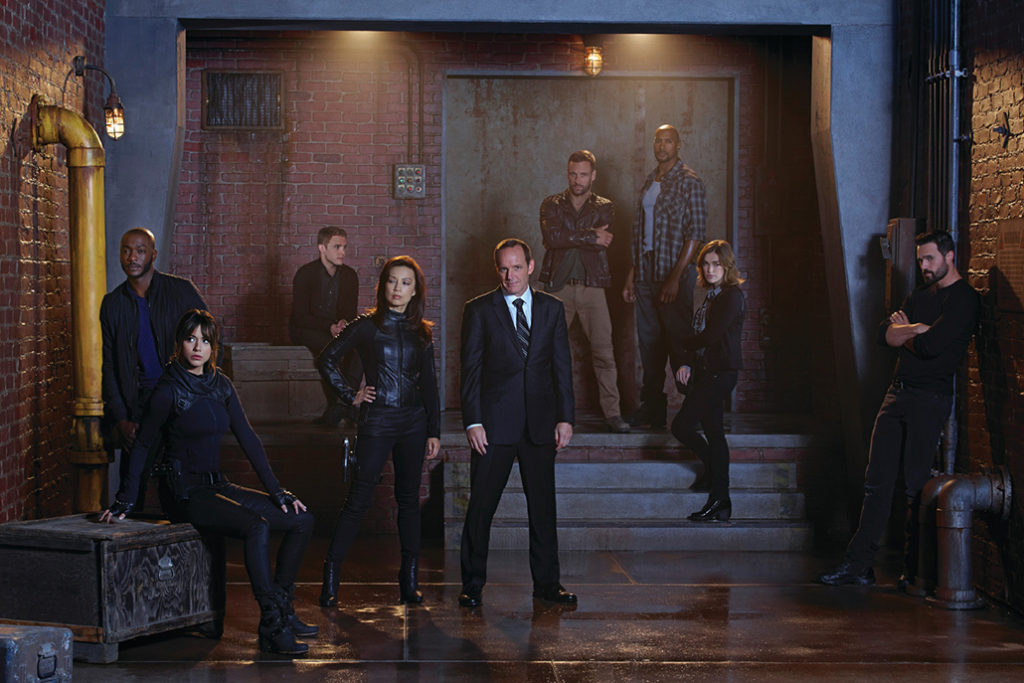
Just as the show itself tells the story of an organized team of spies, agents, heroes and adventurers on a mission to protect the world from nefarious forces and shadow conspiracies from realms near and far, the editorial mission requires a similarly dedicated team largely built out of editors and assistants previously connected to some of the show’s producers on past projects like Buffy the Vampire Slayer, Fringe, Psyche and others. The show currently features three editors: Charson, David Crabtree and Eric Litman. Each has a full-time dedicated assistant editor: Jennifer MacFarlane, Kelly Stuyvesant and Benni Pierce, respectively, while a fourth, Ryan R. Moos, functions as visual effects editor, responsible for collaborating with the visual effects department on an average of 150 visual effects shots per episode.
Each editing team rotates episodes and works, for the most part, autonomously on individual 43-minute, six-act shows throughout the season. With each episode usually shooting for eight days of principal photography (plus two-to-four days of second unit work), the editorial cycle typically only permits editors three days to craft a first cut before cycling through collaborative sessions, first with directors, then producers, before allowing the studio and network time to provide notes.
From the last day of dailies to locking picture, the team normally gets 10-to-12 days to complete each episode, but schedule crunches at certain times during the season can compress that time frame even more, according to the editors. Crabtree suggests that while the cutting methodology is standard in many respects, “The tremendous amount of footage for some episodes can make for a really big challenge to make sure we are finding the best stuff, to be sure.”
Operating out of what Crabtree calls “a crazy bunker” at Culver Studios in Culver City, the editorial team works in a dedicated office alongside visual effects supervisor Mark Kolpack and in close proximity to writers, producers and the show’s primary stages. Given the huge volume of material generated for each episode, having the show’s brain trust ensconced together at Culver really pays off, according to MacFarlane.
“The amount of footage is truly director-dependent, but on a really big action episode there can also be an action unit day in there, which results in double the footage,” she relates. “Since the show is shot at Culver Studios, it’s a huge benefit to have the writers, crew and post staff right there. Any time there is an issue or question, our post producer, Chris Cheramie, can go to set and deal directly with the appropriate department. As a result, our workflow is pretty streamlined. Specific to post, having the actors at the same location helps our post producers interact directly with them during ADR.”
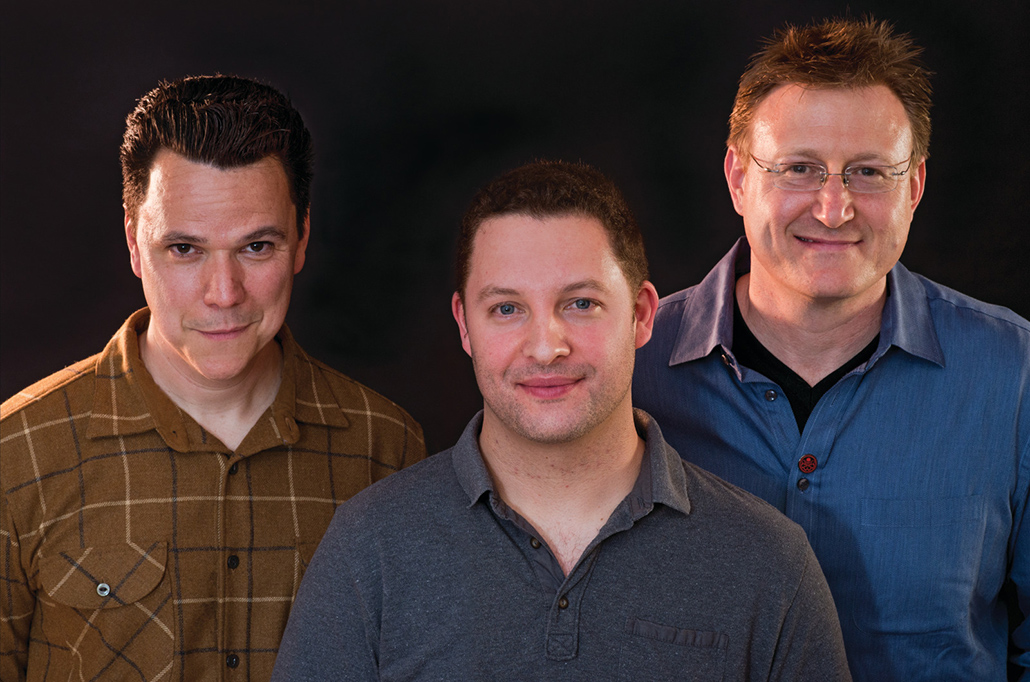
The editorial facility has eight Avid Media Composer workstations, each connected to a pair of 24-inch Samsung monitors — two stations for each editor/assistant editor team, one for the effects assistant editor and an additional workstation dedicated to encoding and compressions so as not to tie up other computers.
“We all have our own editing bay,” explains Benni Pierce. “Each bay consists of a six-core Mac Pro running Mountain Lion with 12GB of RAM. We edit on Media Composer, and everyone uses 7.0.4, except for Moos, whose machine runs 6.5. Through our Avid ISIS shared storage network, each system can access dailies, along with libraries of sound effects, music and visual effects. For security purposes, these machines are not permitted to access the Internet. Any and all files that are uploaded are done through a separate machine.”
The assistants organize bins and media according to each editor’s preferences, with only subtle differences between each group. “When we get the offline media, we transfer it to a partition on the ISIS specifically created for whichever episode we are working on,” Pierce explains. “The media is then transferred into the project, and we begin the process of organizing it. Each scene is given its own bin, and as the media comes in, we move the files to their specific scenes. Within the scene bins, we group the multi-cam footage and then organize the footage in the thumbnail view based on the lined script notes. We then mark the clips whenever ‘action’ is called, using markers.
“Sometimes, multi-colored markers are used if some takes run over multiple scenes, which happens more than you might think,” he continues. “This is where there’s a slight deviation from editor to editor. Eric, for example, likes to have markers whenever there is a reset or bump in dialogue during the take. Dave, on the other hand, likes any resets to be sub-clipped out from the master, which results in more clips within his scene bins.”
That said, Stuyvesant points out, “No one is trying to reinvent the wheel. Each editor has his preferences and quirks, but the overall structure of the edit projects is pretty similar, and we all strive for clarity and organization, making any project easy to navigate. We’re all great at communicating with one another too, and Jennifer,Benni, Ryan and I collaborate on organization and maintaining our shared media.”
SETTING THE TONE
The complexity of the show’s developing plot lines and the way they are woven into the greater Marvel universe was illustrated as Season One wound down last spring, when events in the Marvel feature Captain America: Winter Soldier (2014) directly impacted the storyline in Agents of S.H.I.E.L.D. by changing the very nature and direction of the title organization upon which the show is based: S.H.I.E.L.D., an acronym for Strategic Homeland Intervention, Enforcement and Logistics Division. Those kind of curveballs and other plot developments are discussed in weekly “tone meetings” with writers, directors and producers — meetings to which editors are not typically invited. But here, such meetings are essential in keeping editors updated on a constantly evolving creative landscape.
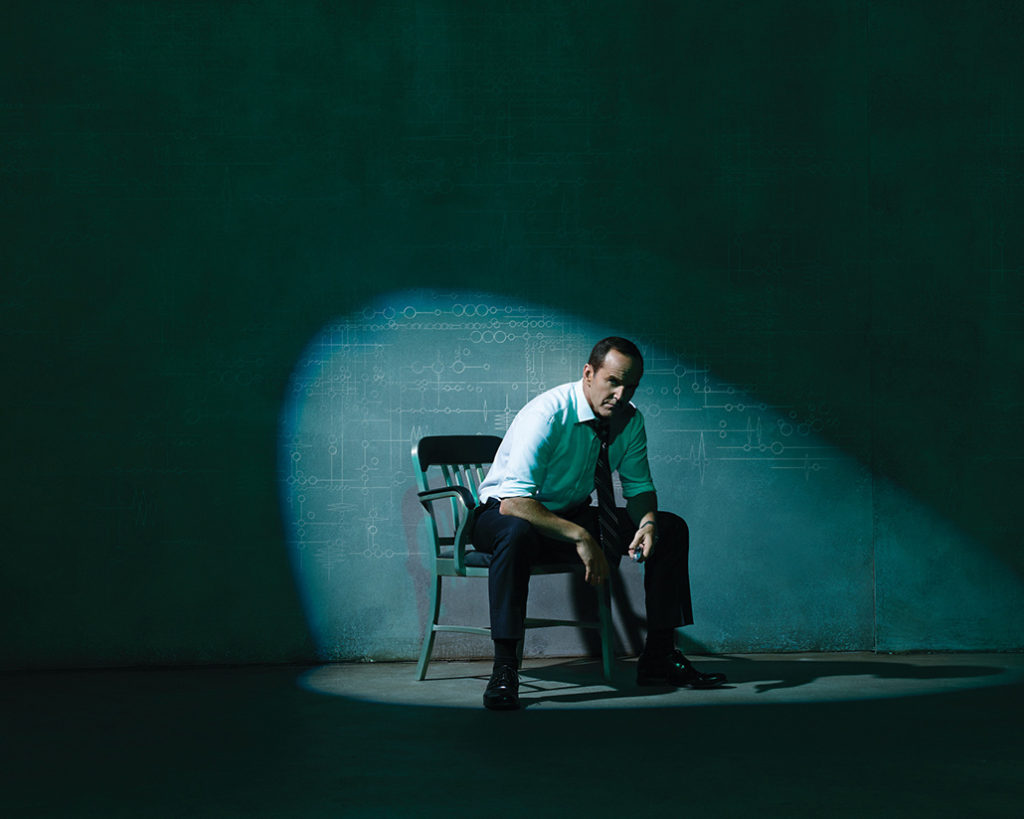
“It’s incredibly valuable to sit in on tone meetings,” Charson says. “Many nuances and details that you might not grasp just from reading the script alone are shared in those meetings, along with other things transpiring in the larger Marvel universe. As an editor, you are a bit of a fly on the wall in there. It’s an opportunity to hear all the subtext thoroughly explained.”
Litman adds that the meetings are also crucial because they help editors understand exactly what producers want— not only from each episode, but from each scene — and provide hints about how they can best balance the show’s pace between keeping it brisk overall and “playing out moments” when they are of sufficient importance.
“I take detailed notes at those meetings,” he adds. “When a key moment is happening, we like to play it out. Usually, I find that the contrast from fast pace to letting things play out a bit allows those moments to happen better, to give the viewer a chance to breathe. If there is an emotional scene, like one of the ones I cut this season where Agent Phil Coulson [Clark Gregg] is interacting with Skye [Chloe Bennet] in a way he hadn’t done before — more fatherly. I let that play out longer and it turned out to be more effective, but that’s because it contrasts with the typical pace.”
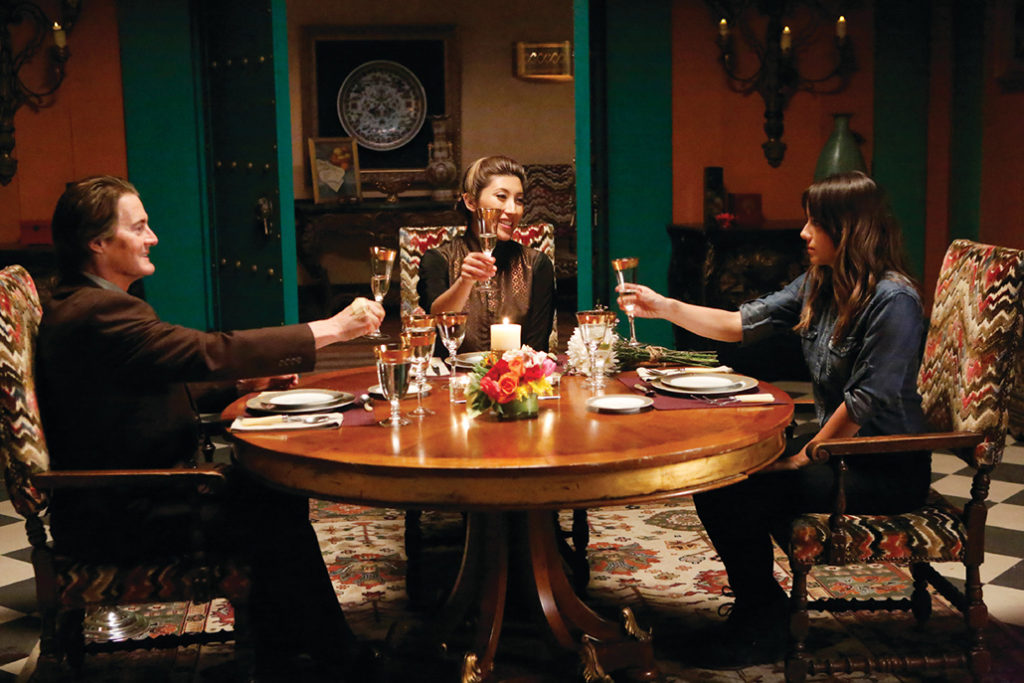
Another editing theme, according to Crabtree, is to pay homage to the show’s comic book roots, when feasible. One way to do this, he says, is to periodically position shots to somewhat resemble the style of actual comics panels.
“When you look at comic books, they usually show very tight shots and then very wide shots,” Crabtree explains. “We tend to do a lot of that: big, cinematic wide shots, then we move in very tight. We follow that template to some extent. We also have lots of sizes like any TV show, with close-ups, medium shots and so forth.”
Another way of evoking a comic book sensibility, and making hardcore fans happy at the same time, involves paying homage to familiar images involving particular characters. This is particularly important when it comes to fight sequences, where true fans expect look, style and movement that evoke what they are familiar with from comics. A prototypical example would be the debut early in Season Two of the Bobbi Morse character (Adrianne Palicki), who eventually is revealed to have the baton weapons, fighting methods and a certain pose of the comic book character known as Mockingbird.
Her debut in a big fight came in an episode Litman edited. “We have a great second unit team that shoots the fights; they do a fantastic job and give us lots of options,” Litman says. “One of the first fights I cut this season was Palicki’s first episode, the reveal of Mockingbird. I made sure to use the most impactful, dynamic angles, making sure she looked like a superhero.”
Because at its heart, the show is about spies and features constant betrayals and misdirections, the editors also face the requirement to sneak in lots of subtle bits designed to evoke ideas or reactions or to foreshadow a story element being developed, but without slowing down the pace of the primary action. Quick glances of suspicion or guilt are commonplace, and there are reams of other elements that are part and parcel of the footage constantly rolling into the editorial department. Each week, this leaves editors with numerous, difficult choices about what elements to trim out among the dozens available for each sequence.

Charson suggests this is among the hardest parts of the job, but at the end of the day, the rule of thumb for dealing with it revolves around adhering to the principle of maintaining a consistently brisk pace, whenever in doubt. “We have lots of hard choices with so much good material,” he says. “Our target story length each episode is 43 minutes, and our first cuts typically come in on average about six minutes longer than that.
“One phrase executive producer Jeffrey Bell uses regarding our characters and dialogue is ‘snappy crackers,’” he continues. “He means he wants smart, fast dialogue, so if a first cut of a scene is playing slow, we’ll first take a pass at removing any redundancies. Then, if we’re still a couple minutes over, we have more difficult choices about how to get the show down to time. This can be heartbreaking and difficult to do.”
THE EFFECT OF EFFECTS
One crucial issue the editorial team grapples with is the large volume of visual effects shots, but the proximity of the visual effects team is a central component in navigating this issue and developing protocols each episode for learning early enough in the editorial process what the proper length and nature of each digital shot needs to be. This is crucial, according to Charson, because “We’re on an incredibly tight schedule. Whereas, in a feature film, you might have six months to work on a VFX shot, we’re lucky to have three or four weeks. Working closely with Kolpack is a central component in navigating the material and getting sequences locked down early enough for our artists to get the shots done.”
He adds that effects supervisor Kolpack himself used to be an assistant editor and has an intimate understanding of editorial. “We will actually block things out together,” Charson explains. “And sometimes, while still in dailies, he will express his vision for the sequence. After that, we bring in our executives to integrate their notes on the material, and get the footage out the door to our artists.”
Moos elaborates that editing teams will freely create temporary effects. He and the visual effects department will then coordinate between editorial and the effects vendors to make sure any editorial changes are clearly translated at all levels.
“We discuss what the editor’s intention is regarding the look and timing of an effect, to ensure that the vendor understands this,” Moos explains. “Additionally, as we are going through the show, locating effects and pulling shots, the assistants do a good job at communicating with us when something in the cut has changed, which we then must evaluate and either tell the vendor to change, stop or add work. Once a show is locked, visual effects takes more control of the show; however, tracking the show up until that point is critical, since any missed or changed effect could result in not being able to air on time.”
The editorial team also plays a key role in laying down templates for the rest of the post chain in the category of audio effects. Charson says the show’s editorial infrastructure allows the editors to create full, temp sound beds and effects, and to collaborate closely with the sound department on specialized sound effects. In fact, MacFarlane relates, “Sound is a huge part of our job, and a lot of times we are creating sounds that don’t exist in the real world, so it takes time and involves a lot of layering.” Her colleague Pierce calls this work the creation of “soundscapes during the offline stages to help tell the story to the audience.”
Such combinations of elements make Agents of S.H.I.E.L.D. about as challenging a job for the three editing teams as there is in network television — but well worth it, as Charson emphasizes. “We’re producing a show that is next to impossible to pull off on network TV,” he claims. “Huge action sequences, mountains of visual effects and tight deadlines all add into that equation. Things can get a little ugly when our backs are up against airdates, but somehow we get it done.
“For me, the thrill of working with these great writers and talented cast is incredibly exciting,” Charson summarizes. “And it helps me manage the stress!”



